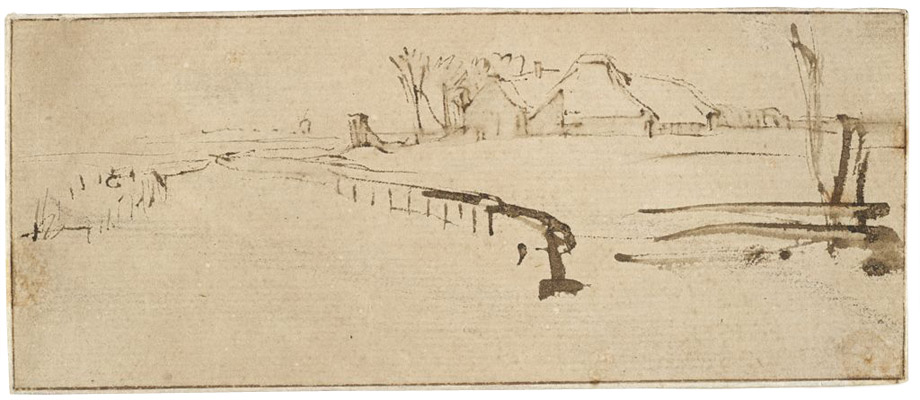It’s no secret that the Harvard Art Museums hold one of the most significant drawings collections in the country. With more than 12,000 drawings by many important artists from the 14th century to the present, it is unparalleled among American university museums.
“What’s fantastic about our drawings collection is that it combines the interesting, the good, and the great, which is perfect for teaching in a university context,” said Edouard Kopp, the Maida and George Abrams Associate Curator of Drawings.
The strength of these objects as educational tools is abundantly evident in two new exhibitions on view this summer, Drawings from the Age of Bruegel, Rubens, and Rembrandt, and Flowers of Evil: Symbolist Drawings, 1870–1910, as well as in related events and programming. Each show, which will be on display until August 14, has approximately 40 works; Bruegel, Rubens, and Rembrandt highlights some of the best examples of the museums’ Netherlandish, Dutch, and Flemish drawings from the 16th and 17th centuries, and Flowers of Evil features late 19th- to early 20th-century symbolist drawings from across Europe and the United States.
Focusing on drawings not only makes sense curatorially but also serves to celebrate all that the museums’ new facility has to offer. “This is a great moment for us,” Kopp said, “because we are able to make the most of our renovated building, with high-quality exhibitions and events, including gallery talks for the public and close study opportunities for promising drawings scholars. In addition, the Art Study Center brings visitors into close proximity with this treasure trove of drawings. Generations of Harvard students, as well as other visitors, have learned from these works, and will continue to do so.”
Roots of the Collection
Drawings have been at the heart of the museums’ collections since the turn of the 20th century, and have long been a focus of study and attention. The collection has been built and nurtured by many individuals—not least of whom are the curators who have looked after it.
Founding curator of drawings (and later director of the Fogg Museum) Agnes Mongan (1905–1996) was the first to pay special attention to developing the museums’ drawings holdings, working alongside Fogg Museum associate director Paul Sachs. William W. Robinson, the third to oversee the museums’ drawings collection and now the Maida and George Abrams Curator of Drawings, emeritus, recalls that Sachs “realized we’d never be able to collect paintings that would be an illustration of the whole history of Western art. But he thought we could do this with drawings. So he set out with his own money and his formidable fundraising and donor cultivation skills to create that drawings collection.”
Sachs’s gifts, and his 1965 bequest, to the Fogg Museum totaled nearly 500 European and American drawings. He also collaborated with Mongan on the two-volume Drawings in the Fogg Museum of Art (1940), the first comprehensive catalogue of drawings to be published in the United States.
Mongan oversaw the donation and accession of a number of other important groups of drawings, starting with a bequest of drawings from Charles A. Loeser in 1932. The Loeser collection included many works by Old Masters; one example is Rembrandt’s Landscape with a Farmstead (“Winter Landscape”), which is featured in the Bruegel, Rubens, and Rembrandt exhibition.
The vast Winthrop collection, a 1943 bequest of Grenville L. Winthrop, added a variety of significant drawings to the museums’ holdings. Flowers of Evil features several of these works, such as Odilon Redon’s evocative Head of a Young Woman.
Steady Growth
The second half of the 20th century witnessed continued growth in the drawings collection through gifts, bequests, and curatorial purchases. The second curator of drawings, Konrad Oberhuber (1935–2007), in his role from 1975 until 1987, forged strong relationships with esteemed collectors. He was also a charismatic teacher, inspiring many students to become drawings scholars and collectors. His efforts improved the museums’ holdings in previously underrepresented areas, including in his area of expertise, Netherlandish drawings of the 16th century.
Oberhuber’s successor for the following 25 years, William Robinson further developed the museums’ holdings of northern European drawings. While Robinson was curator, a gift from Maida and George Abrams of 110 drawings from their private collection of 17th-century Dutch works significantly bolstered the collection, adding depth that was formerly lacking in the representation of Dutch artists. Robinson’s tireless research in this field, as well as his project to catalogue the 100 best examples of Dutch, Flemish, and Netherlandish art from the 16th and 17th centuries, culminates in this summer’s exhibition, as well as its accompanying publication. (Robinson’s work will be further explored in an upcoming Index article.)
As Edouard Kopp settles into his role as the museums’ fourth drawings curator, he is focused on expanding the collection as well as bringing more students, scholars, and visitors into close contact with original works. This summer’s exhibitions and events are only a start, he said.
“It’s our duty as the repository of one of the finest drawings collections in the country not only to make these works accessible—and they are, through exhibitions, rotations, and the Art Study Center—but also to help the budding generation of scholars and collectors to equip their gaze, to know how to look at drawings, and to study them,” Kopp said.




